Editor’s Note: This is a joint review post since we’ve received both PC and Vita review copies of Retro City Rampage. Stick around for Steven Strom’s take on the Vita version.
Imitation is the sincerest form of flattery. Parody should, therefore, be a much less sincere form, exaggerated imitation to the point of ridiculousness. This is the fine line that Retro City Rampage has to walk, tiptoeing carefully to revere the long list of gaming history it cribs influence from rather than outright mocking the classics. There’s a big “parody” disclaimer every time you boot up Retro City Rampage, but the sense of mockery, a tongue-in-cheek attempt to keep that list in the center of the frame is almost forgotten. What remains is one of the most reverential tributes to gaming’s early days, for better or worse.
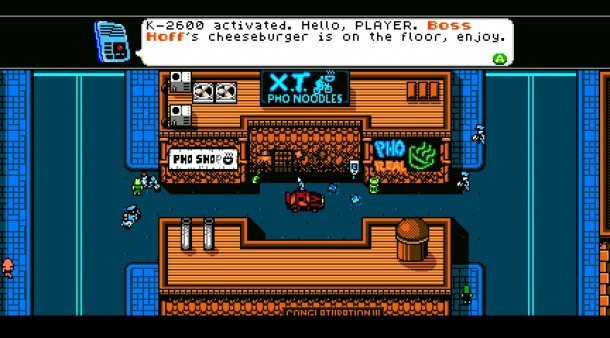
There’s not much in the way of setup here: you are Player, a slick-talking mullet-headed man with a penchant for mayhem and explosions. Inspired and originally prototyped as a top-down Grand Theft Auto de-make, you’ll traverse around the city of Theftropolis in search of whatever odd job and scraps of cash you can get your hands on. With every turn, some new reference will poke its head out at you, most too obvious to ignore despite copyright-avoiding palette swaps. It’s hard to mistake a DeLorean or Adam West’s Batman, and even harder to avoid running through homages to a multitude of classic games.
Missions act as the central impetus to move forward, most revolving around a Christopher Lloyd-esque Doc Choc’s plan to build a working time machine. In this pursuit, he sends Player down Memory Lane to engage in homages to Tapper, Bionic Commando, RoboCop, and Super Mario Bros. While most of the game is spent in a top-down perspective, there will be the occasional switch-up to side-scrolling underwater levels, 3D sprite-scaling races and even a nod at Smash TV, multiple copies of rooms and all. This variety lends Retro City Rampage a bit of a “grab bag” feeling. As Player progress through his story, the less exciting and the more frustrating these missions begin to feel. These feelings are amplified by his tacit acknowledgment of how some gaming concepts were better left to die. After slogging through a frustrating, explosives-ridden combat sequence, he’ll remark, “Oh man! Not another water level!” Another water level ensues, just as obnoxious as it was in 1985.
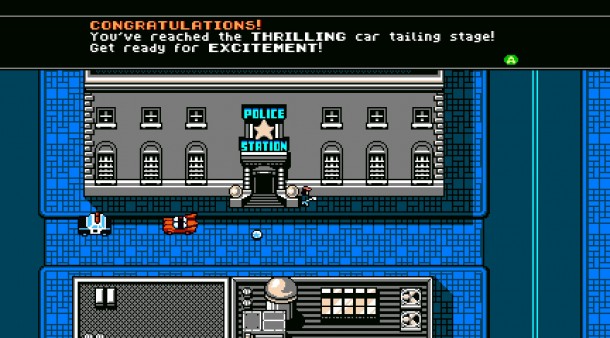
Self-aware humor is the ever-present stopgap, Player’s interactions with questgivers loaded with slight jabs at the past and grammatical errors. Again, the reverence of old-school video games starts off innocent enough, turning into something grating and unnecessary by the end. Player will “conveniently” have to travel all the way across the city for no reason other than “convenience’s” sake in some quests, and mid-stage checkpoints range the gamut from acceptable to deplorable and inconsistent. As the game reaches its final missions, game design borrows too many ideas from classic games that result in quick “gotcha” deaths and abject frustration. Miring in parodical humor doesn’t mean imitation to a “T”, but too many moments in Retro City Rampage’s latter half feel more imitative than humorous.
This would all be a bit forgivable if RCR’s storyline was as self-aware as its gameplay. Dr. von Buttnick serves as the main antagonist, the head of a game publisher dedicated to tricking indie developers into signing away their lives and their game ideas. His plan? Seek out Doc Choc’s time machine and travel to the future, stealing all the best game concepts to sell in the present. For a game that bases its entire existence on the re-imagining of old game concepts, it seems incredibly cynical to call out major publishers in such a way.
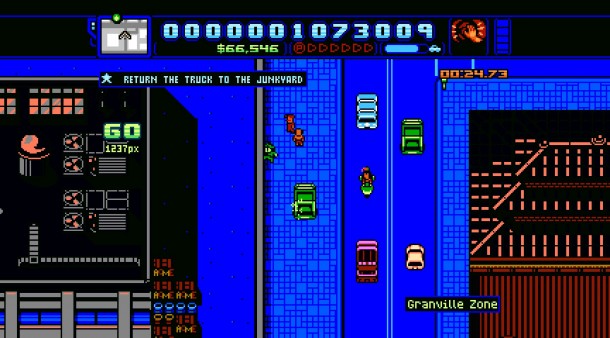
With this heavy-handed damnation of publishers in a central spotlight, there is a hefty score of references to other indie developers and people working within the games industry today. Nolan’s Arcade features homages to Bit.Trip RUNNER and Super Meat Boy alike, while a ‘Splosion Man mini-game pops up along with an homage to the series in the form of a playable Sweat Bomber character. The credits’ “Special Thanks” section might as well be a “who’s who?” of notable developers, journalists and industry names alike, giving nods to Destructoid, Sony and more. There’s a wide community that’s helped to influence Retro City Rampage, and seeing that list scroll by gives a good idea of just how many people contributed in some way or another.
At the end of the day, the fine line between parody and imitation is one Retro City Rampage stumbles over a time or two. Player might have free reign over the city by the end of his journey, but I don’t know if I’ll make my way back to see what he’s up to again. The city of Theftropolis is one drowning in nostalgia, waves upon waves of 8-to-16-bit goodness crashing on its shores with each mission stage Player completes, but by the end the water’s a little too low to enjoy swimming in.
This review is based on a copy of Retro City Rampage for the PC provided by the publisher and GoG.com to SideQuesting.
[divider]
A Second Glance (PS Vita):
It would be easy to say that Retro City Rampage is just the latest example of popular culture swallowing its own tail. And to an extent, that’s true. However, whereas Family Guy and The Big Bang Theory scramble to pander any and every image or quote they can shove down their audiences’ gullets, Retro City Rampage’s references come from a true place of reverence. The game’s creator has reached deep and wide in order to collect some truly obscure moments so that even the most dedicated of gamers won’t be able to recognize them all.
That doesn’t help the game’s sense of personality, unfortunately. Retro City Rampage doesn’t have a personality. While the references may be cute and even sometimes clever, their over-caffeinated bombardment of the player is just a tiresome, unidentifiable blur.
That being said, the Vita version of Retro City Rampage is likely the best out of the three. Nothing about the game is substantially different, beyond controls and screen size. But playing on the handheld means that you can more easily digest the game in smaller bites.
The minute the game’s sensibilities become tiring, you can put the Vita into sleep mode and pick up where you left off later. This applies to Retro City Rampage’s hyperkinetic gameplay as well, keeping the best part of the game feeling fresh. That and you absolutely want to play this game with dual analog sticks.
If Retro City Rampage on consoles is like pouring a bag of artificial sweetener into your mouth, then playing it on Vita is like eating that same amount in restaurant-sized packets. It’s without substance, but enjoyable enough in small doses. And it won’t make you choke.

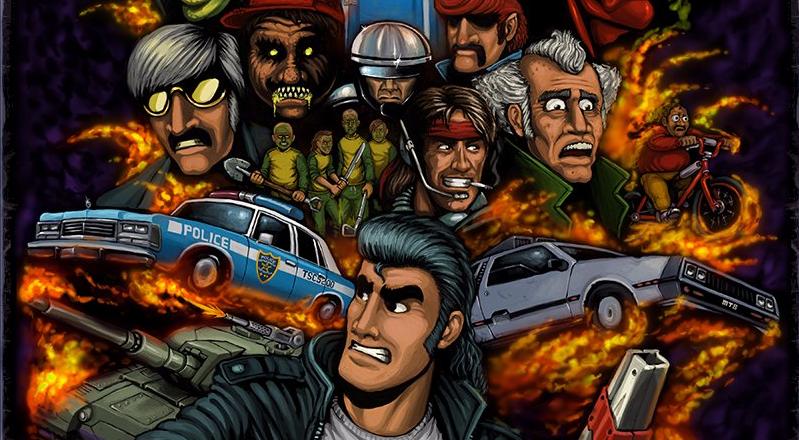
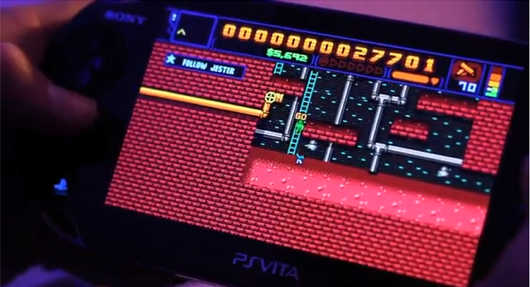
No Comments